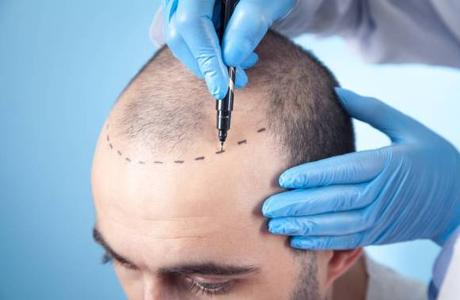Hair loss can happen to both men and women, and it can affect one's confidence. In fact, male and female pattern baldness or 'pattern alopecia' affects 50% of people and is one of the most common causes of hair loss. (1)
Maybe you've noticed your hairline creeping back a bit, or perhaps your once-thick ponytail feels a little thinner these days. Whatever the case, you're wondering what you can do to get a fuller head of hair again.

The good news is you're not out of luck! There are a bunch of different hair replacement options out there these days. Some involve a quick trip to the doctor's office, while others are things you can do from the comfort of your own home.
But with so many choices, it can feel overwhelming to pick the right one. Here's a quick breakdown for you:
Surgical hair restoration
Surgical hair restoration is a great choice if you're looking for a long-term, maybe even permanent, solution to hair loss. The most common surgery is hair transplant. In fact, more than 735,000 hair restoration procedures were performed worldwide in 2019. (2)
Here's how it works: a skilled surgeon carefully removes healthy hair follicles from an area on your scalp that's less likely to go bald, usually the back or sides of the head. Think of it like borrowing strong, healthy hair from one place to fill in the thinner areas.
Then, the surgeon meticulously transplants these follicles into the spots where your hair is thinning or gone completely. Over time, the transplanted hair starts to grow naturally and blends in perfectly with your existing hair. So, it ends up looking like your own hair all along!
Advantages

Here are the advantages of surgical hair transplant:
Natural-looking results
The best hair transplant method provides the most natural-looking hair restoration available. The transplanted follicles continue to grow throughout your life, mimicking the growth pattern of your original hair.
Long-lasting effects
Surgical hair replacement is believed to be a permanent solution for hair loss. Once the transplanted follicles establish themselves, it may be unlikely to fall out again - albeit with proper care and maintenance.
Scalp reduction surgery
For some individuals with significant hair loss, scalp reduction surgery might be an option. This procedure removes loose scalp tissue, bringing the remaining hair closer together and creating the illusion of denser hair.
Disadvantages
Here are the disadvantages of surgical hair restoration:
Invasive procedure
Hair transplants are surgical procedures, and as with any surgery, there are potential risks like infection and scarring.
Downtime
While minimally invasive, hair transplants do require some recovery time. You may experience swelling and discomfort in the scalp for a few days following the procedure.
Cost
Surgical hair restoration procedures can be expensive, depending on the extent of hair loss and the surgeon's expertise.
Donor availability
Not everyone is a good candidate for hair transplants. The success of the procedure relies on having a healthy donor area on the scalp with sufficient hair follicles for transplantation.
Non-surgical hair restoration
Non-surgical hair restoration methods offer a variety of approaches to address hair loss. These are generally less invasive and require minimal to no downtime.
Here's a closer look at some popular non-surgical options:
Medicines
Two medicines, Minoxidil and Finasteride, have been approved by the FDA (Food and Drug Administration). These can help slow down hair loss and, in some cases, make some new hair grow.
Laser treatment
Low-level laser therapy uses concentrated beams of light that shine on the scalp. This might help with hair growth.
Hairpieces
Wigs, toupees, and hair systems are artificial hair that you can wear on your head. They cover up hair loss right away. These come in different styles and materials to match the color and texture of your natural hair. The diverse choices are most likely one of the reasons why the hairpieces market was valued at USD$ 6.46 billion in 2022 and is projected to grow even more in the coming years. (3)
Advantages
Here are the advantages of non-surgical hair restoration:
Less invasive
Compared to surgery, non-surgical methods are less invasive and carry fewer risks.
Cost-effective
Generally, non-surgical options are more affordable than surgical procedures.
Convenient
Many non-surgical methods, like medications and laser therapy, can be done from the comfort of your home or require minimal time in a clinic.
No downtime
Most non-surgical methods don't require any downtime, allowing you to resume your daily activities immediately.
Disadvantages
Here are the disadvantages of non-surgical hair restoration:
Temporary results
Medications and laser therapy may take several months to show results, and their effectiveness can vary depending on the individual. These methods often require ongoing use to maintain any regrowth achieved.
Maintenance
Hairpieces require regular cleaning and maintenance to ensure they look their best. They might not be suitable for everyone, especially those with active lifestyles, as they can feel uncomfortable during exercise or other similar activities.
Choosing the right hair replacement method
So, which hair replacement method is right for you? There's no single answer to this. The best approach depends on several factors, including:
Severity of hair loss
If you're experiencing major hair loss, a surgical procedure like a hair transplant might be the most effective solution. For mild to moderate hair loss, non-surgical options like medications or laser therapy might be sufficient.
Desired results
If getting back a full head of hair that looks completely natural is your top priority, then surgical hair restoration might be the best choice for you. It's a long-lasting solution that mimics your natural hair growth.
On the other hand, if you'd prefer something quicker and easier on your body, even if the results might not last forever, non-surgical methods are worth considering. These can be a great option if you're comfortable with the idea of ongoing maintenance or touch-ups.
Lifestyle
Think about your lifestyle and how much time and effort you're willing to invest in hair restoration. Surgical procedures require some recovery time and may not be ideal for someone with a busy schedule. Non-surgical methods, like medications or laser therapy, can be incorporated more easily into a daily routine.
Budget
Hair restoration can vary significantly in cost. Surgical procedures are typically more expensive upfront, while non-surgical methods may require ongoing costs for medication or hairpiece maintenance.
In conclusion
Seeing your hair thinning out can be a real blow. It's normal to feel discouraged, but here's the good news: you've got options! There's a whole bunch of hair restoration methods out there that can help you get back to a fuller head of hair.
Learn about the different approaches, think about what matters most to you, and talk to a hair restoration specialist. This way, you can achieve the results you're hoping for and strut your stuff with a healthy, beautiful head of hair!
Fraquoh and Franchomme
P.S. We want to hear from you! Have you had or considered having hair implants? Did they work? What technology did you use? Share your feedback, questions or thoughts in the comments below! For more articles on style, fashion tips and cultural insights, you can subscribe to Attire Club via e-mail or follow us on Facebook, Twitter or Instagram!
References
- "Everything You Need to Know About Hair Loss", Source: https://www.healthline.com/health/hair-loss#symptoms:~:text=of%20hair%20loss%3A-,Androgenic%20alopecia,-Androgenic%20alopecia%20refers
- "Hair Transplantation in the United States: A Population-based Survey of Female and Male Pattern Baldness", Source: https://www.ncbi.nlm.nih.gov/pmc/articles/PMC10642908/#:~:text=More%20than%20735%2C000%20surgical%20hair%20restoration%20procedures%20were%20performed%20worldwide%20in%202019
- "Hair Wigs And Extensions Market Size, Share & Trends Analysis Report By Product", Source: https://www.grandviewresearch.com/industry-analysis/hair-wigs-extensions-market-report

